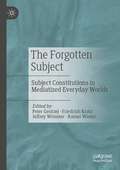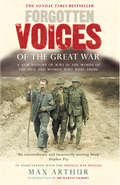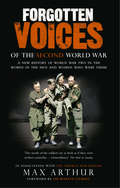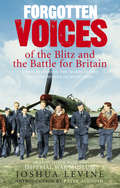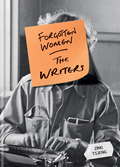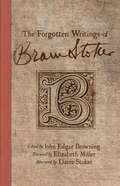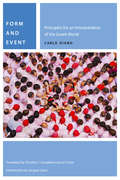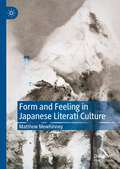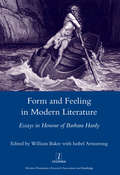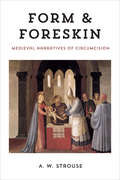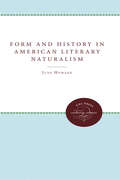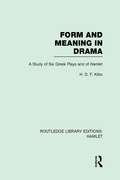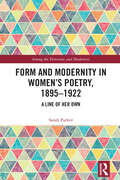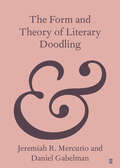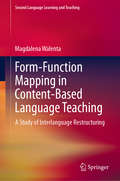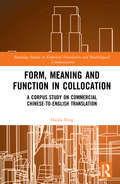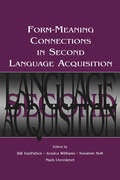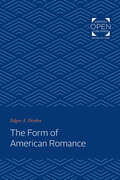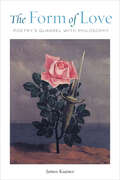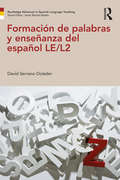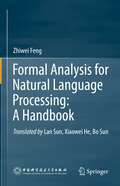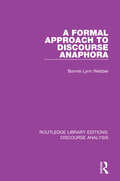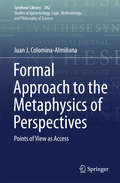- Table View
- List View
The Forgotten Subject: Subject Constitutions in Mediatized Everyday Worlds
by Peter Gentzel Friedrich Krotz Jeffrey Wimmer Rainer WinterThe volume provides a critical inventory of existing concepts of the subject in communication studies research. In addition, concepts are developed in order to be able to analyze subjectivity in the context of current theoretical debates (including media sociology, cultural studies, psychoanalysis, practice theory, science and technology studies) as well as social, cultural and technical developments (including digitalization, mediatization, mobility and networking). Since subject conceptions are of central importance for any communication and media analyses, the volume fills a central gap in communication and media studies.
Forgotten Voices Of The Great War
by Max ArthurIn 1960, the Imperial War Museum began a momentous and important task. A team of academics, archivists and volunteers set about tracing WWI veterans and interviewing them at length in order to record the experiences of ordinary individuals in war. The IWM aural archive has become the most important archive of its kind in the world. Authors have occasionally been granted access to the vaults, but digesting the thousands of hours of footage is a monumental task. Now, forty years on, the Imperial War Museum has at last given author Max Arthur and his team of researchers unlimited access to the complete WWI tapes. These are the forgotten voices of an entire generation of survivors of the Great War. The resulting book is an important and compelling history of WWI in the words of those who experienced it.
Forgotten Voices Of The Second World War: A New History of the Second World War in the Words of the Men and Women Who Were There
by Max ArthurThe Imperial War Museum holds a vast archive of interviews with soldiers, sailors, airmen and civilians of most nationalities who saw action during WW2. As in the highly-acclaimed Forgotten Voices of the Great War, Max Arthur and his team of researchers spent hundreds of hours digging deep into this unique archive, uncovering tapes, many of which have not been listened to since they were created in the early 1970s. The result will be the first complete oral history of World War 2. We hear at first from British, German and Commonwealth soldiers and civilians. Accounts of the impact of U.S. involvement after Pearl Harbour and the major effects it had on the war in Europe and the Far East is chronicled in startling detail, including compelling interviews from U.S. and British troops who fought against the Japanese. Continuing through from D-Day, to the Rhine Crossing and the dropping of the Atom Bomb in August 1945, this book is a unique testimony to one of the world's most dreadful conflicts. One of the hallmarks of Max Arthur's work is the way he involves those left behind on the home front as well as those working in factories or essential services. Their voices will not be neglected.
Forgotten Voices of the Blitz and the Battle For Britain: A New History in the Words of the Men and Women on Both Sides
by Joshua LevineDrawing material from the Imperial War Museum's extensive aural archive, Joshua Levine brings together voices from both sides of the Blitz and the Battle of Britain to give us a unique, complete and compelling picture of this turbulent time.In June 1940, British citizens prepared for an imminent German onslaught. Hitler's troops had overrun Holland, Belgium and France in quick succession, and the British people anticipated an invasion would soon be upon them. From July to October, they watched the Battle of Britain play out in the skies above them, aware that the result would decide their fate. Over the next nine months, the Blitz killed more than 43,000 civilians. For a year, the citizens of Britain were effectively front-line soldiers in a battle which united the country against a hated enemy.We hear from the soldiers, airmen, fire-fighters, air-raid wardens and civilians, people in the air and on the ground, on both sides of the battle, giving us a thrilling account of Britain under siege. With first-hand testimonies from those involved in Dunkirk and the Battle of Britain, Black Saturday on 7th September 1940 when the Luftwaffe began the Blitz, to its climax on the 10th May 1941, this is the definitive oral history of a period when Britain came closer to being overwhelmed by the enemy than at any other time in modern history.
Forgotten Women: The Writers (Forgotten Women Ser.)
by Zing Tsjeng'To say this series is "empowering" doesn't do it justice. Buy a copy for your daughters, sisters, mums, aunts and nieces - just make sure you buy a copy for your sons, brothers, dads, uncles and nephews, too.' - IndependentThe women who shaped and were erased from our history.Forgotten Women is a new series of books that uncover the lost herstories of influential women who have refused over hundreds of years to accept the hand they've been dealt and, as a result, have formed, shaped and changed the course of our futures. From leaders and scientists to artists and writers, the fascinating stories of these women that time forgot are now celebrated, putting their achievements firmly back on the map.The Writers celebrates 48* unsung genius female writers from throughout history and across the world, including the Girl Stunt Reporters, who went undercover to write exposés on the ills of 1890s America; Aemilia Lanyer, the contemporary of Shakespeare whose polemical re-writing of The Bible's Passion Story is regarded as one of the earliest feminist works of literature; and Sarojini Naidu, the freedom fighter and 'Nightingale of India' whose poetry echoed her political desire for Indian independence.Including writers from across a wide spectrum of disciplines including poets, journalists, novelists, essayists and diarists, this is an alternative gynocentric history of literature that will surprise, empower, and leave you with a reading list a mile long.*The number of Nobel-prize-winning women.
Forgotten Women: The Writers (Forgotten Women)
by Zing Tsjeng'To say this series is "empowering" doesn't do it justice. Buy a copy for your daughters, sisters, mums, aunts and nieces - just make sure you buy a copy for your sons, brothers, dads, uncles and nephews, too.' - IndependentThe women who shaped and were erased from our history.Forgotten Women is a new series of books that uncover the lost herstories of influential women who have refused over hundreds of years to accept the hand they've been dealt and, as a result, have formed, shaped and changed the course of our futures. The Writers celebrates 48* unsung genius female writers from throughout history and across the world, including the Girl Stunt Reporters, who went undercover to write exposés on the ills of 1890s America; Aemilia Lanyer, the contemporary of Shakespeare whose polemical re-writing of The Bible's Passion Story is regarded as one of the earliest feminist works of literature; and Sarojini Naidu, the freedom fighter and 'Nightingale of India' whose poetry echoed her political desire for Indian independence.Including writers from across a wide spectrum of disciplines including poets, journalists, novelists, essayists and diarists, this is an alternative gynocentric history of literature that will surprise, empower, and leave you with a reading list a mile long.*The number of Nobel-prize-winning women.
The Forgotten Writings Of Bram Stoker
by John Edgar BrowningPresented here, for the first time since their publication over a century ago, are twelve previously unknown published works of fiction, poetry, and journalistic writing by Bram Stoker (1847-1912), three works never before reprinted, twelve period writings about Stoker, and the rare 1913 estate sale catalogue of his personal library.
Form and Event: Principles for an Interpretation of the Greek World (Commonalities)
by Carlo DianoCarlo Diano’s Form and Event has long been known in Europe as a major work not only for classical studies but even more for contemporary philosophy. Already available in Italian, French, Spanish, and Greek, it appears here in English for the first time, with a substantial Introduction by Jacques Lezra that situates the book in the genealogy of modern political philosophy.Form and Event reads the two classical categories of its title phenomenologically across Aristotle, the Stoics, and especially Homer. By aligning Achilles with form and Odysseus with event, Diano links event to embodied and situated subjective experience that simultaneously finds its expression in a form that objectifies that experience. Form and event do not exist other than as abstractions for Diano but they do come together in an intermingling that Diano refers to as the “eventic form.” On Diano’s reading, eventic forms interweave subjectively situated and embodied experiences, observable in all domains of human and nonhuman life.A stunning interpretation of Greek antiquity that continues to resonate since its publication in 1952, Form and Event anticipates the work of such French and Italian post-war thinkers as Gilles Deleuze, Alain Badiou, Roberto Esposito, and Giorgio Agamben.
Form and Feeling in Japanese Literati Culture
by Matthew MewhinneyThis book explores how two early modern and two modern Japanese writers – Yosa Buson (1716–83), Ema Saikō (1787–1861), Masaoka Shiki (1867–1902), and Natsume Sōseki (1867–1916) – experimented with the poetic artifice afforded by the East Asian literati (bunjin) tradition, a repertoire of Chinese and Japanese poetry and painting. Their experiments generated a poetics of irony that transformed the lineaments of lyric expression in literati culture and advanced the emergence of modern prose poetry in Japanese literature. Through rigorous close readings, this study changes our understanding of the relationship between lyric form and the representation of self, sense, and feeling in Japanese poetic writing from the late eighteenth through the early twentieth century. The book aims to reach a broad audience, including specialists in East Asian Studies, Anglophone literary studies, and Comparative Literature.
Form and Feeling in Modern Literature: Essays in Honour of Barbara Hardy
by Isobel Armstrong"Essays, short stories and poems by eminent creative writers, critics and scholars from three continents celebrate the literary achievements of Barbara Hardy, the foremost exponent of close critical reading in the latter half of the twentieth century and today. Her work, as the essays in the volume bear witness, encompasses 19th and 20th century British fiction, poetry, and Shakespeare. In addition to an introduction outlining and assessing Hardy's career and writing, there is an extensive bibliography of her work. Comparatively short, concise essays, stories and poems by twenty distinguished hands express the eclectic nature of Barbara Hardy's work and themselves form a many-faceted critical/creative gathering. Form and Feeling moves away from the traditional festschrift to create an innovative critical genre that reflects the variety and nature of its subject's work. In addition to Barbara Hardy's own writing, authors and subjects treated include Anglo-Welsh poetry, nineteenth century fiction, Margaret Atwood, Wilkie Collins, Ivy Compton Burnet, Charles Dickens, George Eliot, Elizabeth Gaskell, G. M. Hopkins, Wyndham Lewis, George Meredith, Alice Meynell, Harriet Beecher Stowe, Shakespeare, and W. B. Yeats, amongst others."
Form and Foreskin: Medieval Narratives of Circumcision
by A. W. StrouseWhy did Saint Augustine ask God to “circumcise [his] lips”? Why does Sir Gawain cut off the Green Knight’s head on the Feast of the Circumcision? Is Chaucer’s Wife of Bath actually—as an early glossator figures her—a foreskin? And why did Ezra Pound claim that he had incubated The Waste Land inside of his uncut member? In this little book, A. W. Strouse excavates a poetics of the foreskin, uncovering how Patristic theologies of circumcision came to structure medieval European literary aesthetics. Following the writings of Saint Paul, “circumcision” and “uncircumcision” become key terms for theorizing language—especially the dichotomies between the mere text and its extended exegesis, between brevity and longwindedness, between wisdom and folly. Form and Foreskin looks to three works: a peculiar story by Saint Augustine about a boy with the long foreskin; Sir Gawain and the Green Knight; and Chaucer’s Wife of Bath’s Tale. By examining literary scenes of cutting and stretching, Strouse exposes how Patristic treatments of circumcision queerly govern medieval poetics.
Form and History in American Literary Naturalism
by June HowardExamining the novels of Frank Norris, Theodore Dreiser, Jack London, and other writers, June Howard presents a study of American literary naturalism as a genre. Naturalism, she states, is a way of imagining the world and the relation of the self to the world, a way of making sense -- and making narrative -- out of the comforts and discomforts of its historical moment.Howard believes that naturalism accomodates the sense of perilousness, uncertainty, and disorder that many Americans felt in the late nineteenth and early twentieth centuries. She argues for a redefinition of the form which allows it to be seen as an immanent ideology responding to a specific historical situation. Working both from accepted definitions of naturalism and from close analysis of the literary texts themselves, Howard consructs a new description of the genre in terms of its thematic antinomies, patterns of characterization, and narrative strategies. She defines a range of historical and cultural reference for the ideas and images of American naturalism and suggests that the form has affinities with such contemporary ideologies as political progressivism and criminal anthropology. In the process, she demonstrates that genre criticism and historical analysis can be combined to create a powerful method for writing literary history.Throughout Howard's study, the concept of genre is used not as a prescriptive straitjacket but as a category allowing the perception of significant similarities and differences among literary works and the coordination of textual analysis with the history of literary and social forces. For Howard, naturalism is a dynamic solution to the problem of generating narrative from the particular historical and cultural materials available to the authors.Originally published in 1985.A UNC Press Enduring Edition -- UNC Press Enduring Editions use the latest in digital technology to make available again books from our distinguished backlist that were previously out of print. These editions are published unaltered from the original, and are presented in affordable paperback formats, bringing readers both historical and cultural value.
Form and Meaning in Drama: A Study of Six Greek Plays and of Hamlet (Routledge Library Editions: Hamlet)
by H. D. KittoAnalysing six Greek tragedies - the Orestes triology, Ajax, Antigone and Philoctetes - and Hamlet, this book also contains a chapter on the Greek and the Elizabethan dramatic forms and one on religious drama. This is an important work from an author respected for a constructive and sensitive quality of criticism.
Form and Modernity in Women’s Poetry, 1895–1922: A Line of Her Own (Among the Victorians and Modernists)
by Sarah ParkerWhile W. B. Yeats’s influential account of the ‘Tragic Generation’ claims that most fin-de-siècle poets died, or at least stopped writing, shortly after 1900, this book explodes this narrative by attending to the twentieth-century poetry produced by women poets Alice Meynell, Michael Field (Katharine Bradley and Edith Cooper), Dollie Radford, and Katharine Tynan. While primarily associated with the late nineteenth century, these poets were active in the twentieth century, but their later writing is overlooked in modernist-dominated studies, partly due to this poetry’s adherence to traditional form. This book reveals that these poets, far from being irrelevant to modernity, used these established forms to address contemporary concerns, including suffrage, sexuality, motherhood, and the First World War. The chapters focus on Meynell’s manipulations of metre to contemplate temporality and literary tradition; Michael Field’s use of blank verse to portray the conflicted modern woman; Radford’s adaptation of the aesthetic song-like lyric to tackle the experience of the city, urban crime, and suffrage; and Tynan’s employment of the ballad to soothe bereaved mothers during the First World War. This book ultimately shows that traditional forms played a vital role in shaping mature women poets’ responses to modernity, illuminating debates about form, tradition, and gender in twentieth-century poetry.
The Form and Theory of Literary Doodling (Elements in Publishing and Book Culture)
by null Jeremiah R. Mercurio null Daniel GabelmanThis Element investigates the phenomenon of literary doodling—the making of playful verbal and visual creations by professional authors while engaged in another activity. The first part focuses on defining the form and structure of doodles, comparing and contrasting them with adjacent genres such as sketches, caricatures, and illustrations. The second part explores the modality of doodling, examining doodles through the lenses of spectrality, liminality, and play. Drawing on a wide range of theories and backed up with numerous close readings, the Element argues that doodles, despite their apparent triviality, provide valuable insights into the creative processes, authorial habits, and finished works of literary doodlers. Ultimately, this study aims to legitimise doodles as worthy of serious critical attention, demonstrating how they trouble the meaning of texts, introduce semantic flexibility into literary works and their reception, and rejuvenate the joy of readerly discovery.
Form-Function Mapping in Content-Based Language Teaching: A Study of Interlanguage Restructuring (Second Language Learning and Teaching)
by Magdalena WalentaThis book presents a form-function mapping (FFM) model for balancing language and content gains within content-based language teaching (CBLT). It includes a theoretical part, which outlines the FFM model and, drawing on the analysis of eclectic teaching methods and interlanguage restructuring, proposes pedagogical tools for its implementation. These tools, which encourage mapping of language forms onto content knowledge, are hypothesized to facilitate interlanguage restructuring, thus helping CBLT learners in their struggle with L2 morpho-syntax. The empirical section presents the results of a quantitative–qualitative study conducted among adult L1 Polish learners of English in a CBLT context. It then goes on to translate the findings, which reveal that the FFM model has a positive and significant influence on interlanguage restructuring as well as a favorable reception among CBLT learners, into a set of pedagogical guidelines for practitioners.
Form, Meaning and Function in Collocation: A Corpus Study on Commercial Chinese-to-English Translation (Routledge Studies in Empirical Translation and Multilingual Communication)
by Haoda FengThe issue of differences between translational language and native-speaker language has become a topic of increasing interest in linguistics and Translation Studies (TS). One of the primary tasks in this research area is to employ a corpus approach and analyse collocations with authentic language data by comparing comparable corpora consisting of translated and native-speaker texts. Collocation in linguistics and TS refers to the relationship of co-occurrence between lexical items. The book shows that examining the use of collocations constitutes an integral part in assessing the naturalness of second language (L2) use, and therefore can be a valid measure to make a distinction between translational language and native-speaker language. Nevertheless, the role of collocation has not been given enough attention or discussed systematically in TS and, to date, there are hardly any translation theorists who have clarified the mechanism of collocation in TS, by which translators acquire receptive and productive knowledge of collocations in their L2. In addition, previous research in this area is largely confined to Indo-European languages, resulting in a lack of empirical evidence involving Asian languages. This book therefore attempts to bridge the gap in the literature and constitute an integral part in the research area.
Form-Meaning Connections in Second Language Acquisition (Second Language Acquisition Research Series)
by Jessica Williams Bill VanPatten Susanne Rott Mark OverstreetForm-Meaning Connections in Second Language Acquisition is an interdisciplinary and timely edited book of essays and empirical studies, most of which are based on the papers presented at the Form and Meaning Conference held in Chicago in 2002. The goal of the conference and now of the book is to present linguistic and cognitive approaches to second language acquisition, attempting to integrate external and internal issues in interlanguage development, while outlining directions for future research. The editors address questions, such as: What is the nature and sequence of the form-meaning mapping process? How are these connections made? How are these connections used to construct grammars and lexicons? And, how can conditions and external factors be manipulated to improve the chances of making these form-meaning connections?Contributors to this volume include such second language acquisition scholars as Susan Gass, Nick Ellis, Kathleen Bardovi-Harlig, Catherine Doughty, and Diane Larsen-Freeman. They address these form-meaning issues from a variety of settings and from multiple perspectives.Researchers and graduate students in applied linguistics, cognitive psychology, linguistics, and language pedagogy will find this volume to be an important resource.
The Form of American Romance
by Edgar DrydenOriginally published in 1988. Edgar Dryden challenges recent criticism that has tended to discredit—or at least devalue—the importance of "romance" as a thematic and generic category of American fiction. In The Form of American Romance, he examines its evolution and meaning through readings of five exemplary texts: Hawthorne's Marble Faun, Melville's Pierre, James's Portrait of a Lady, Faulkner's Absalom, Absalom!, and Barth's Letters. Each of these novels treats the problems of reading and writing in a self-referential way that reflects on the questions they dramatize, and Dryden has chosen each with the others in mind. Taken together, they chart a line of development with representative examples of what literary history calls romanticism, realism, modernism, and postmodernism, and thus they suggest a certain story about the continuity of the American novel.
The Form of Love: Poetry’s Quarrel with Philosophy
by James KuznerCan poetry articulate something about love that philosophy cannot? The Form of Love argues that it can. In close readings of seven “metaphysical” poems, the book shows how poets of the early modern period and beyond use poetic form to turn philosophy to other ends, in order not to represent the truth about love but to create a virtual experience of love, in all its guises. The Form of Love shows how verse creates love that can’t exist without poetry’s specific affordances, and how poems can, in their impossibility, prompt love’s radical re-imagining. Like the philosophies on which they draw, metaphysical poems imagine love as an intense form of non-sovereignty, of giving up control. They even imagine love as a liberating bondage—to a friend, a beloved, a saint, a God, or a garden. Yet these poems create strange, striking versions of such love, made in, rather than through, the devices, structures, and forces where love appears.Tracing how poems think, Kuzner argues, requires an intimate form of reading: close—even too close—attention to and thinking with the text. Showing how poetry thinks of love otherwise than other fields, the book reveals how poetry and philosophy can nevertheless enter into a relation that is itself like love.
Formación de palabras y enseñanza del español LE/L2 (Routledge Advances in Spanish Language Teaching)
by David Serrano-DoladerFormación de palabras y enseñanza del español LE/L2 offers a unique combination of theory and practice that guides the reader through the main processes of word formation in Spanish. It provides a detailed analysis of the role of lexical creation in the acquisition of L2 Spanish vocabulary, as well as over a hundred practical self-reflection activities. Key features: • Comprehensive theoretical explanations of word formation, including theoretical and pedagogical principles and their implementation in the teaching of L2 Spanish; • Step-by-step pedagogical introductions to the full range of lexical creation mechanisms in Spanish language, including prefixation, emotive and nonemotive suffixation and composition; • Carefully-chosen lists of relevant issues on lexical morphology with immediate applicability to the teaching of L2 Spanish; • Guided activities with an answer key, which helps the reader to connect theory with practice and to become familiar with the key aspects of Spanish lexical morphology; • Guidelines on how to tackle the teaching of Spanish word formation and vocabulary in an effective and engaging way. Written in a clear and accessible manner, Formación de palabras y enseñanza del español LE/L2 is an essential resource for teachers of Spanish at all levels. It is also an excellent reference book for language teachers who wish to integrate word formation into the teaching of the Spanish language.
Formal Analysis for Natural Language Processing: A Handbook
by Zhiwei FengThe field of natural language processing (NLP) is one of the most important and useful application areas of artificial intelligence. NLP is now rapidly evolving, as new methods and toolsets converge with an ever-expanding wealth of available data. This state-of-the-art handbook addresses all aspects of formal analysis for natural language processing. Following a review of the field’s history, it systematically introduces readers to the rule-based model, statistical model, neural network model, and pre-training model in natural language processing. At a time characterized by the steady and vigorous growth of natural language processing, this handbook provides a highly accessible introduction and much-needed reference guide to both the theory and method of NLP. It can be used for individual study, as the textbook for courses on natural language processing or computational linguistics, or as a supplement to courses on artificial intelligence, and offers a valuable asset for researchers, practitioners, lecturers, graduate and undergraduate students alike.
A Formal Approach to Discourse Anaphora (RLE: Discourse Analysis)
by Bonnie Lynn WebberFirst published in 1979, this book starts from the perspective that dealing with anaphoric language can be decomposed into two complementary tasks: 1. identifying what a text potentially makes available for anaphoric reference and 2. constraining the candidate set of a given anaphoric expression down to one possible choice. The author argues there is an intimate connection between formal sentential analysis and the synthesis of an appropriate conceptual model of the discourse. Some of the issues with the creation of this conceptual model are discussed in the second chapter, which follows a background to the thesis that catalogues the types of anaphoric expression available in English and lists the types of things that can be referred to anaphorically. The third and fourth chapters examine two types of anaphoric expression that do not refer to non-linguistic entities. The final chapter details three areas into which this research could potentially be extended. This book will be of interest to students of linguistics.
Formal Approach to the Metaphysics of Perspectives: Points of View as Access (Synthese Library #392)
by Juan J. Colomina-AlmiñanaThis book offers a metaphysical development of the notion of perspective. By explaining the functional nature of point of view, and by providing a concrete definition of point of view as a window through which to see the world, it offers a scientific realist theory that explains that points of view are real structures that ground properties and objects as well as perspectives. The notion of point of view has been of key importance in the history of philosophy, and different philosophical schools have used this notion to conduct analyses from the external reality to the inner phenomenal status, or even to construct an entire philosophical system. However, there has been a lack of systematic analysis of what a point of view is and what its structure is; this book fills the gap in the literature and makes the transition between semantics and epistemology, and the philosophy of science.
Formal Approaches to Languages of South America
by Cilene Rodrigues Andrés SaabThis book analyzes the linguistic diversity of South America based on approaches deeply rooted in the tradition of formal grammar. The chapters brought together in this contributed volume consider native languages all kinds of languages used in the region, including sign languages, indigenous languages and the romance languages (Portuguese and Spanish) originally introduced by European colonizers which underwent processes of transformation giving rise to new, local grammars. One fourth of the language families of the world are located in South America, but the majority of languages in the region are still understudied and out of the radar of theoretical linguistics mostly because their grammars are not well-known by international researchers. This book aims to fill this gap by bringing together studies rooted in the formal grammar approach first developed by Noam Chomsky, which sees language not only as mere corpora attested in oral and written production, but also as expressions of systems of thought and language production which are essential parts of human cognition. The book is divided in three parts – sign languages, romance languages and indigenous languages –, and brings together studies of the following South American languages: Brazilian Sign Language (Libras - Língua Brasileira de Sinais)Argentinian Sign Language (LSA - Lengua de Señas Argentina)Peruvian Sign Language (LSP- Lengua de Señas Peruana)Brazilian PortugueseChilean and Argentinian SpanishQuechuaParaguayan GuaraniA’ingaeMacro-Jê languages Formal Approaches to the Languages of South America will be an invaluable resource both for theoretical linguists and cognitive scientists by providing access to top quality research on understudied languages and enabling these languages to be incorporated into comparative studies that can contribute to advance the knowledge of general principles governing all human languages.
